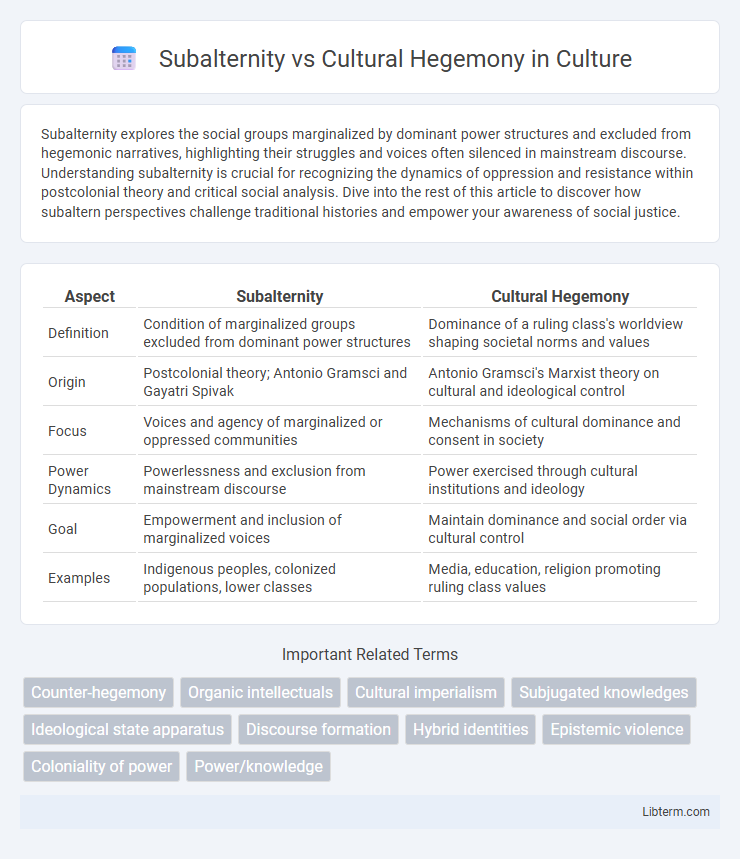Subalternity explores the social groups marginalized by dominant power structures and excluded from hegemonic narratives, highlighting their struggles and voices often silenced in mainstream discourse. Understanding subalternity is crucial for recognizing the dynamics of oppression and resistance within postcolonial theory and critical social analysis. Dive into the rest of this article to discover how subaltern perspectives challenge traditional histories and empower your awareness of social justice.
Table of Comparison
| Aspect | Subalternity | Cultural Hegemony |
|---|---|---|
| Definition | Condition of marginalized groups excluded from dominant power structures | Dominance of a ruling class's worldview shaping societal norms and values |
| Origin | Postcolonial theory; Antonio Gramsci and Gayatri Spivak | Antonio Gramsci's Marxist theory on cultural and ideological control |
| Focus | Voices and agency of marginalized or oppressed communities | Mechanisms of cultural dominance and consent in society |
| Power Dynamics | Powerlessness and exclusion from mainstream discourse | Power exercised through cultural institutions and ideology |
| Goal | Empowerment and inclusion of marginalized voices | Maintain dominance and social order via cultural control |
| Examples | Indigenous peoples, colonized populations, lower classes | Media, education, religion promoting ruling class values |
Understanding Subalternity: Definition and Origins
Subalternity refers to the marginalized groups in society who lack access to hegemonic power and voice, as theorized by scholars like Antonio Gramsci and later expanded by Gayatri Spivak. It originates from postcolonial studies and Marxist theory, emphasizing the systemic exclusion and oppression experienced by subordinate social groups. Understanding subalternity involves recognizing the power dynamics that silence these groups and the challenges in representing their agency within dominant cultural narratives.
Gramsci’s Concept of Cultural Hegemony
Gramsci's concept of cultural hegemony explains how dominant groups maintain power by shaping cultural norms, beliefs, and values, making their ideology seem natural and inevitable. Subalternity refers to marginalized groups excluded from the dominant power structures and lacking agency within hegemonic culture. Understanding cultural hegemony is crucial to analyzing how subaltern groups resist or are integrated into the dominant cultural framework.
Historical Contexts of Subaltern Voices
Subalternity emerges from postcolonial theory to describe marginalized groups excluded from dominant power structures, often silenced in historical narratives. Cultural hegemony, a concept developed by Antonio Gramsci, explains how ruling classes maintain control through ideological dominance rather than force. Historical contexts reveal subaltern voices as crucial for challenging hegemonic discourses and exposing the power dynamics underpinning colonial and postcolonial societies.
Mechanisms of Cultural Domination
Mechanisms of cultural domination under subalternity involve the marginalization and silencing of oppressed groups, reinforcing their exclusion from dominant cultural narratives. Cultural hegemony operates through the normalization of ruling class ideologies, embedding power structures within societal institutions and everyday practices. Both concepts reveal how culture serves as a battlefield where domination is exercised not only by force but through consent and ideological control.
Intersectionality in Subaltern Experiences
Subalternity examines marginalized groups whose voices are suppressed within dominant power structures, while cultural hegemony explores how ruling classes maintain control through ideological dominance. Intersectionality reveals how overlapping social identities--such as race, class, gender, and ethnicity--compound subaltern experiences, intensifying systemic oppression and complicating resistance strategies. Understanding subalternity through an intersectional lens challenges monolithic narratives and highlights the nuanced realities of diverse marginalized communities under cultural hegemony.
Resistance to Hegemonic Power Structures
Subalternity represents marginalized groups excluded from dominant power structures, making their voices often unheard within society. Cultural hegemony, as theorized by Antonio Gramsci, describes how ruling classes maintain control by shaping societal norms and values to appear natural and beneficial. Resistance to hegemonic power structures emerges through subaltern agency, employing counter-narratives, alternative cultural expressions, and grassroots activism to challenge and destabilize dominant ideologies.
The Role of Language in Oppression and Empowerment
Language functions as a crucial instrument in both subalternity and cultural hegemony, shaping power dynamics through discourse and representation. The subaltern's marginalization is perpetuated by dominant hegemonic languages that control knowledge production and restrict access to cultural narratives. Conversely, reclaiming indigenous or marginalized languages fosters empowerment by challenging hegemonic dominance and enabling subaltern voices to assert identity and resist oppression.
Representation and Silencing of Subaltern Groups
Subalternity refers to marginalized groups whose voices are systematically excluded from dominant power structures, resulting in their representation often being constructed through hegemonic cultural narratives. Cultural hegemony maintains control by shaping societal norms and discourses, effectively silencing subaltern groups and limiting their agency in public discourse. This dynamic perpetuates the invisibility of subaltern experiences, reinforcing power imbalances through strategic erasure and misrepresentation in media, literature, and political arenas.
Subaltern Agency: Case Studies and Examples
Subaltern agency emerges as a critical concept in understanding how marginalized groups resist and negotiate dominance within cultural hegemonies, as evidenced by the peasant uprisings in colonial India and the Zapatista movement in Mexico. These case studies highlight subaltern groups actively reclaiming identity and challenging dominant narratives imposed by colonial or neoliberal power structures. The efficacy of subaltern agency is measured through grassroots mobilization, alternative discourse creation, and the disruption of hegemonic cultural practices.
Rewriting Narratives: Future Paths Beyond Hegemony
Subalternity challenges dominant cultural hegemony by amplifying marginalized voices and rewriting historical narratives to include diverse perspectives. Future paths beyond hegemony involve decolonizing knowledge systems and fostering intercultural dialogue that disrupts centralized power structures. Emphasizing subaltern agency cultivates transformative spaces where alternative cultural identities and epistemologies reshape societal discourse.
Subalternity Infographic

 libterm.com
libterm.com